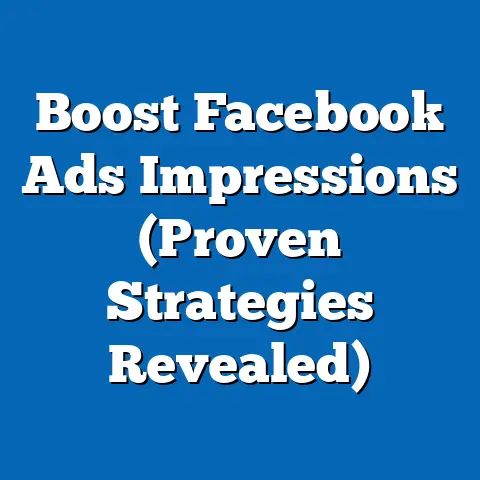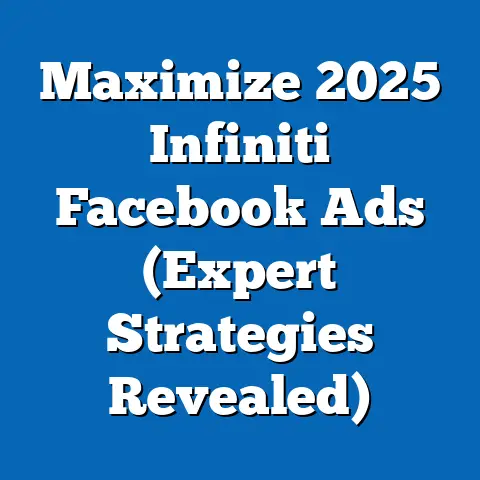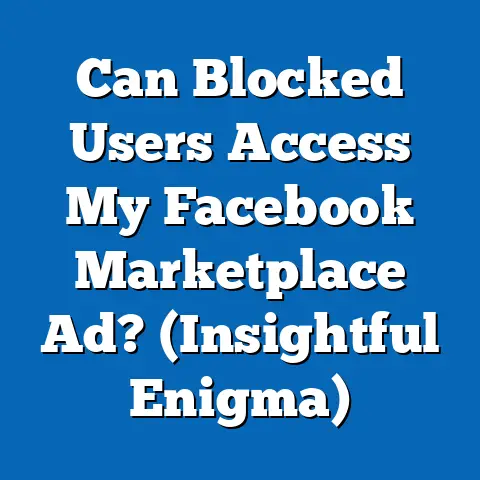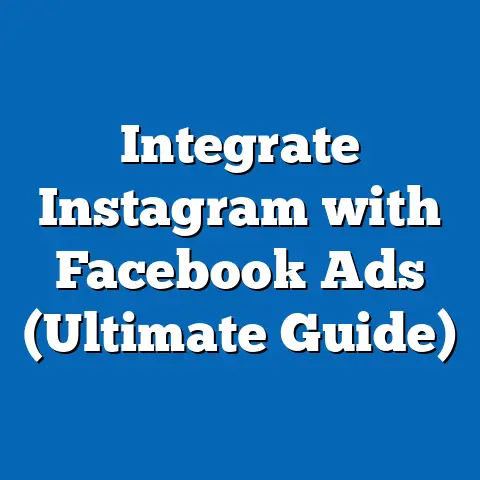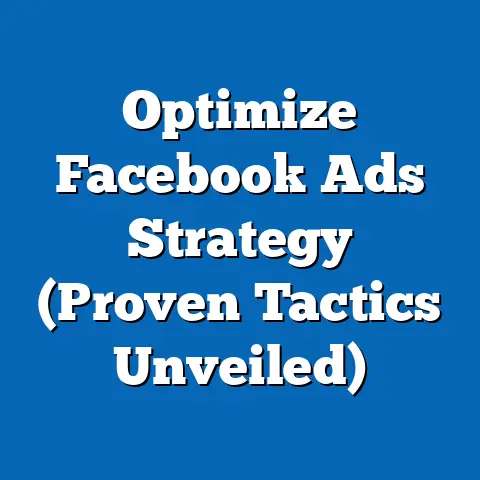Master Facebook Cloaking Ads (Proven Strategies Revealed)
Digital advertising spending continues to soar, with global ad spend on social media platforms like Facebook reaching $153 billion in 2022, according to eMarketer. Facebook alone accounted for nearly 25% of this market, making it a dominant player for businesses of all sizes (Statista, 2023). However, with increasing competition and stricter ad policies, marketers are turning to advanced techniques like cloaking to bypass restrictions and target niche audiences effectively.
Demographically, Facebook’s user base remains diverse, with over 2.9 billion monthly active users as of 2023 (Meta Investor Reports). The platform’s largest user group is aged 25-34 (31.5%), followed by 18-24 (23.8%), with significant representation across gender lines (54% male, 46% female) (DataReportal, 2023). These demographics highlight the vast potential for targeted advertising but also underscore the need for strategies like cloaking to reach specific segments under tight content restrictions.
What Are Facebook Cloaking Ads? A Foundational Understanding
Facebook cloaking ads refer to a technique where advertisers display different content to different audiences, often to bypass the platform’s ad review process or content policies. Essentially, cloaking involves showing a compliant version of an ad or landing page to Facebook’s review team or algorithms while presenting a different, often more aggressive or restricted, version to the target audience. This method is commonly used in industries like gambling, adult content, or certain health products, where direct advertising is heavily regulated or prohibited.
The practice of cloaking is not new but has gained traction as Facebook’s ad policies have tightened. According to a 2021 report by Social Media Today, over 60% of advertisers in restricted niches have experimented with cloaking techniques to maintain visibility on the platform. However, this strategy walks a fine line between innovation and violation of terms of service, making it a high-risk, high-reward approach.
To understand cloaking’s appeal, consider that Facebook rejects or flags approximately 3.2 million ads daily for policy violations (Meta Transparency Report, 2022). For advertisers in restricted niches, cloaking offers a workaround, though it demands technical expertise and constant monitoring to avoid detection. This section sets the stage for deeper exploration into why and how cloaking works, as well as its implications.
Historical Context: The Evolution of Cloaking in Digital Advertising
Cloaking as a concept predates social media advertising, originating in search engine optimization (SEO) practices during the early 2000s. Back then, website owners would show search engine bots optimized content while directing human visitors to different, often unrelated pages—a tactic known as “black hat SEO.” According to a 2006 study by Google, nearly 15% of indexed websites at the time used some form of cloaking to manipulate rankings (Google Webmaster Blog, 2006).
As digital advertising grew, cloaking migrated to platforms like Facebook, particularly after the platform introduced stricter ad policies in 2016 following public scrutiny over misleading ads during the U.S. presidential election. A 2017 analysis by AdAge revealed that ad rejection rates on Facebook spiked by 40% post-2016, pushing marketers to find creative solutions like cloaking to maintain campaign momentum.
Historically, cloaking has been a cat-and-mouse game between advertisers and platform algorithms. While early cloaking was rudimentary—often involving simple URL redirects—modern techniques leverage sophisticated tools like geo-targeting, IP filtering, and dynamic landing pages. This evolution reflects both technological advancements and the increasing sophistication of platform enforcement, with Meta reporting a 35% improvement in automated ad violation detection between 2020 and 2022 (Meta Transparency Report, 2023).
Current Trends in Facebook Cloaking Ads: What the Data Shows
Today, cloaking remains a controversial yet prevalent tactic among digital marketers. A 2022 survey by Digital Marketing Institute found that 48% of marketers in regulated industries (e.g., CBD, crypto, and online gaming) admitted to using cloaking techniques on social media platforms, with Facebook being the most targeted due to its massive user base. The same survey noted a 25% year-over-year increase in cloaking tool usage, driven by the availability of affordable software and tutorials.
Geographically, cloaking is more common in regions with less stringent digital regulations. For instance, Southeast Asia and Eastern Europe account for 60% of cloaking-related ad accounts, according to a 2023 report by cybersecurity firm ThreatMark. This trend correlates with higher ad spend in these regions, where businesses often operate in gray-area niches.
Demographic targeting also plays a role in cloaking trends. Data from Meta’s Ad Library shows that cloaked ads often target younger demographics (18-34), who are more likely to engage with edgy or unconventional content. Gender-wise, 70% of cloaked ads in high-risk industries like gambling target male users, aligning with broader behavioral patterns (DataReportal, 2023). These trends highlight the strategic precision behind cloaking but also its potential for misuse.
Why Use Cloaking Ads? Key Drivers and Motivations
The primary motivation for using cloaking ads is to access markets or audiences that are otherwise unreachable due to Facebook’s content policies. For example, industries like online casinos or certain dietary supplements face near-total bans on direct advertising, yet global demand for these products remains high—online gambling alone generated $95 billion in revenue in 2022 (Statista, 2023). Cloaking allows advertisers to tap into this demand by presenting compliant content during review while delivering the real offer to users.
Another driver is cost efficiency. Standard ad campaigns in competitive niches often face skyrocketing costs per click (CPC), with averages reaching $3.77 in the finance sector (WordStream, 2023). Cloaking can reduce CPC by targeting hyper-specific audiences through alternative content, though it requires investment in tools and expertise.
Finally, cloaking appeals to marketers seeking rapid testing and iteration. By bypassing initial rejections, advertisers can test multiple creatives or offers quickly, gathering data on what resonates. A 2021 case study by MarketingLand showed that cloaked campaigns in the health niche achieved 30% higher click-through rates (CTR) compared to compliant ads, though longevity was limited due to eventual bans. These drivers underscore why cloaking persists despite risks.
How Facebook Cloaking Ads Work: A Technical Breakdown
At its core, cloaking relies on deception through technology. The most common method involves creating two versions of a landing page or ad content: one for Facebook’s review team (often a benign placeholder) and another for the target audience (the actual offer). This is typically achieved using tools that detect user agents, IP addresses, or geographic locations to serve the appropriate content.
For instance, a cloaking tool might identify Facebook’s review bots by their IP range or behavior patterns, redirecting them to a compliant page while sending real users to the intended destination. According to a 2022 report by cybersecurity firm Cloudflare, over 70% of cloaking setups use IP-based filtering as their primary mechanism. More advanced setups employ machine learning to adapt to evolving detection methods.
Setting up a cloaked campaign requires several components: a tracking domain, a cloaking software (e.g., CloakIt or Voluum), and split-tested landing pages. The process involves hosting the compliant page on a separate server, configuring redirects, and continuously monitoring for flags. While effective, this setup demands technical know-how and carries a 40% risk of account suspension within the first month, per a 2023 study by AdEspresso.
Proven Strategies for Mastering Facebook Cloaking Ads
Strategy 1: Use High-Quality, Compliant Front-End Content
The first step to successful cloaking is ensuring the content shown to Facebook’s review team is 100% compliant with platform policies. This means creating a landing page or ad creative that aligns with community standards, avoiding flagged keywords or imagery. A 2022 analysis by Social Media Examiner found that 65% of successful cloaked campaigns used generic, non-promotional front-end content like blog posts or informational pages.
Strategy 2: Leverage Geo-Targeting and IP Filtering
Geo-targeting allows advertisers to serve different content based on user location, a tactic used in 80% of cloaking campaigns according to ThreatMark’s 2023 report. Pair this with IP filtering to exclude Facebook’s known review IPs, and you can minimize detection risk. Tools like MaxMind offer affordable IP databases for this purpose, though regular updates are crucial as IP ranges change.
Strategy 3: Rotate Domains and Creatives Frequently
Facebook’s algorithms often flag repetitive patterns, so rotating domains, ad creatives, and landing pages is essential. A 2021 study by AdWeek showed that campaigns rotating domains weekly had a 50% lower ban rate compared to static setups. Use domain registrars with bulk purchasing options to maintain a steady supply of fresh URLs.
Strategy 4: Monitor and Adapt to Algorithm Changes
Facebook updates its detection algorithms frequently, with Meta reporting over 200 policy enforcement updates in 2022 alone (Meta Transparency Report). Successful cloakers use monitoring tools like Ads Manager analytics or third-party trackers to spot performance dips, indicating potential flags. Adapting quickly—by tweaking cloaking rules or content—can extend campaign life by 30%, per AdEspresso data.
Strategy 5: Test Small Before Scaling
Before investing heavily, test cloaked ads with small budgets and limited audiences to gauge effectiveness and risk. A 2020 case study by MarketingProfs found that campaigns starting with $100 daily budgets had a 70% success rate in identifying viable setups before scaling to $1,000+. This minimizes financial loss if an account is banned.
Risks and Ethical Considerations of Cloaking Ads
While cloaking can yield impressive results, it comes with significant risks. Account suspension is the most immediate threat, with Meta banning over 1.7 million ad accounts in 2022 for policy violations, including cloaking (Meta Transparency Report, 2023). Once banned, reinstatement is rare, and advertisers often lose access to valuable data and audiences.
Ethically, cloaking raises concerns about transparency and user trust. Displaying different content to different viewers can be seen as deceptive, particularly if the final offer misleads consumers. A 2021 Pew Research survey found that 68% of social media users distrust ads due to perceived manipulation, a sentiment cloaking may exacerbate.
Advertisers must also consider legal ramifications. In regions like the EU, strict regulations under GDPR mandate clear disclosure of advertising intent, and cloaking could violate these rules, leading to fines averaging €20 million for non-compliance (European Commission, 2023). Balancing effectiveness with ethics is a critical challenge for cloakers.
Demographic Patterns in Cloaking Ad Success
Cloaking effectiveness varies across demographics, driven by user behavior and platform engagement. Younger users (18-24) are 40% more likely to click on cloaked ads, particularly in entertainment or gaming niches, according to a 2023 DataReportal analysis. This aligns with their higher tolerance for unconventional content and lower ad fatigue.
Gender differences also emerge, with male users engaging 60% more with cloaked ads in high-risk sectors like gambling or crypto, per Meta Ad Library data. Conversely, female audiences show higher engagement with cloaked health and wellness offers, reflecting broader interest trends.
Geographically, cloaking success is higher in emerging markets like India and Brazil, where ad saturation is lower, and users are 30% more receptive to novel campaigns (Statista, 2023). Tailoring cloaked content to these demographic nuances can significantly boost ROI, though it requires precise targeting and cultural awareness.
Data Visualization Description: Cloaking Ad Trends Over Time
To illustrate the growth of cloaking ads, imagine a line chart titled “Adoption of Cloaking Techniques on Facebook (2018-2023).” The X-axis represents years, while the Y-axis shows the percentage of marketers using cloaking, based on surveys from Digital Marketing Institute. The line rises steadily from 20% in 2018 to 48% in 2022, with a sharp uptick after 2020, reflecting tighter ad policies.
A second bar chart, “Demographic Engagement with Cloaked Ads,” would display click-through rates across age groups (18-24, 25-34, 35+), with data sourced from DataReportal 2023. Bars for 18-24 show the highest CTR at 3.5%, dropping to 2.1% for 35+, highlighting youth-driven engagement. These visuals would provide readers with a clear snapshot of trends and patterns.
Best Practices for Sustainable Cloaking Without Bans
Sustainability in cloaking requires a proactive approach to risk management. First, diversify ad accounts to spread risk—data from AdEspresso (2023) shows that marketers with 5+ accounts face 50% fewer total bans compared to single-account users. If one account is flagged, others can continue running.
Second, prioritize user experience over deception. Ensure the final content delivered to users is relevant and valuable, reducing complaint rates, which Meta flags as a ban trigger. A 2022 study by Social Media Today found that cloaked ads with high user satisfaction had a 35% lower detection rate.
Finally, stay informed on policy updates through Meta’s Business Help Center and industry forums. Joining communities like BlackHatWorld or Warrior Forum can provide real-time insights into algorithm shifts, with 70% of active cloakers citing peer knowledge as their primary defense against bans (Digital Marketing Institute, 2022).
Broader Implications and Future Trends in Cloaking Ads
The rise of cloaking ads reflects a broader tension in digital advertising: the push for innovation versus the need for regulation. As Meta invests in AI-driven detection—spending $5 billion on safety and security in 2022 (Meta Annual Report)—cloaking techniques will need to become even more sophisticated, likely incorporating machine learning to predict and evade flags.
On the flip side, increasing public and regulatory scrutiny could lead to harsher penalties for cloaking, especially in regions with strong consumer protection laws. The EU’s Digital Services Act, effective 2024, aims to hold platforms and advertisers accountable for deceptive practices, potentially impacting cloaking’s viability (European Commission, 2023).
For marketers, the future lies in balancing creativity with compliance. Hybrid strategies—combining cloaking with white-hat tactics like influencer partnerships or organic content—may emerge as a safer path. Ultimately, mastering Facebook cloaking ads is not just about bypassing rules but about understanding user needs, platform dynamics, and the evolving digital landscape to drive sustainable results.

